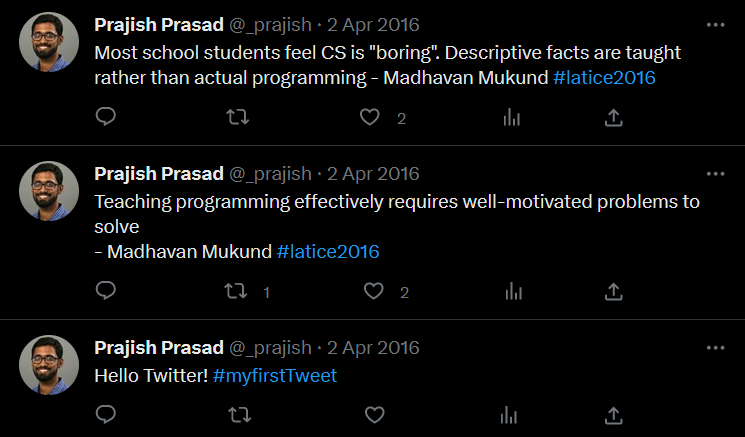Getting started with Twitter as an Academic
I first joined Twitter in 2016 when I was a junior PhD student. At that time, our department was hosting an international conference, and as part of the organising committee, we decided to post questions and reflections of various sessions on Twitter.

From that time on, Twitter has been my main source to get regular updates about what’s happening in my area, and the world in general. What I’ve realised over the years is that Twitter is a great place to get to know what other people in your field are upto - what they are working on, the papers they have published, and the ideas they are grappling with.
Twitter is also a great way to start interactions and discussions with other academics. The idea that Twitter is a townhall is quite accurate. There hasn’t been a time in history when you could directly respond to experienced researchers or influential people in your field.
Twitter also provides you the opportunity to add your own voice and experience into the conversation. This can seem daunting at first - how can you possibly add something to a discussion with experienced people in your field? But that’s how you start. Most of the time, even if you don’t have something to contribute, you can add some nuance to an existing thread or discussion.
However, you may have questions or doubts -
What if no one responds? That’s fine. Get over it. The idea is to put yourself and your ideas and opinions out there.
What if someone shoots your idea down? Even that’s fine. There’s always something valuable to learn from differing opinions and perspectives, as long as you don’t take things personally.
What if someone trolls you? This indeed is a serious issue, and one of the main reasons why several people choose to stay off Twitter. The cost versus the benefit should always be considered.
Twitter as a platform can also be engaging and addictive, that there will be times when you can’t seem to stay off Twitter (that’s what it is designed for!). I quickly realised that I needed a strategy to engage with Twitter in an effective manner.
My Twitter Engagement Strategy
How do I optimise my Twitter usage so that it advances my primary purpose of engaging with the academic community? Here’s what I came up with.
I only follow people whose work/opinions/updates I’m interested in. This may seem obvious, but its very easy to fall into the trap of following Twitter handles of companies, news agencies, funny memes and cat videos. That does not mean that news updates and cat memes are not important; just that they serve as a distraction to my original intent of engaging with the academic community.
I’ve decided that I will engage with Twitter only on particular days. For me, it’s Tuesday and Friday - for 15 minutes each day. I try to stick to these days, and mostly I’m successful. I keep a countdown timer on my computer which let’s me know when my time runs out.
I’ve found that using Twitter twice a week is sufficient for my primary need of engaging with the community. I get important updates and news from people I’m following. Some posts might get missed, and that’s ok.
During each Twitter session, I also try to reply to posts or threads I find interesting, or for which I have a question to ask. Sometimes, you come across an insightful post or thread, and a simple thank you to the author and mentioning why it was interesting is a good way of engaging with others on Twitter.
While scrolling through Twitter, when I come across links to other material, I open them onto a new tab, so that I can refer to these videos/articles/resources after my Twitter session.
Occassionaly, I post questions or thoughts which have been lingering in my mind. (I don’t do this often, but I would like to do it more!) Again, the variety of replies and perspectives from the Twitter-hive helps you re-think through your own position or idea.
So that’s it. I’ve been following this strategy for several years now, and it has served my purpose for engaging with the academic community.